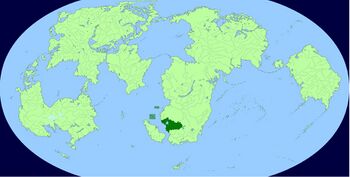Afrasha
This article is incomplete because it is pending further input from participants, or it is a work-in-progress by one author. Please comment on this article's talk page to share your input, comments and questions. Note: To contribute to this article, you may need to seek help from the author(s) of this page. |
Dominion of Afrasha Mulkin na Afrasha | |
|---|---|
|
Flag | |
| Motto: "Mu sama da duka" (Hausa) "We above all." | |
 | |
| Capital | Nagono |
| Largest city | Migoran |
| Official languages | Hausa |
| Ethnic groups |
|
| Demonym(s) | Afrashan |
| Government | Unitary Totalitarian Hereditary Dictatorship |
| Tinorma Vilya | |
| Minano Dinwa | |
| Legislature | National Council |
| Population | |
• 14 A.W estimate | 72,410.148 |
• 10 A.W. census | 69.896.448 |
| GDP (nominal) | 10 A.W. estimate |
• Total | $720.982 billion |
• Per capita | $10,315 |
| Gini (10 A.W.) | medium |
| HDI (10 A.W.) | high |
| Currency | Afrashan Vil (AFV) |
| Date format | dd/mm/yyyy |
| Driving side | right |
| Calling code | +44 |
| Internet TLD | .af |
Afrasha officially the Dominion of Afrasha is a country in southwestern continent bordered by countries. Afrasha is an advanced nation that focuses on domination and expansion. The country has been ruled by the Vilya family for over 700 years after the royal family was overthrown in 721 B.W. Since then, the Vilyas have had varying types of rule. Currently, the country is experiencing an economic and scientific boom which has fueled the expansionist ideology of the people and government. The Nora and Natusha Islands have aided in Afrashan maritime expansion and trade, expanding their sphere of influence.
Etymology
History
Vilya Sieze of Power
Repopulation Program
In 155 B.W., Supreme Leader Magna Vilya ordered the start of the Afrashan Repopulation Program, which lasted until 87 B.W. This was created to curb the rapidly declining population of Afrasha at the time, after multiple other failed incentives. The program marks an era of high biological human research, high population growth, and extreme violations of human rights. Hospital facilities were constructed and people were kidnapped by the government to produce as many children as biologically possible. This raised the fertility rate from 0.5 in 155 B.W to 3.6 in 150 B.W. to 5.4 in 140 B.W. The Supreme Leader took this opportunity to create children with the most desirable physical characteristics and genes. People who were brought to these facilities did not leave until they became infirtile or turned 35. Children born into the program were taken by the country to raise after one year. During the program, Afrashans lived in constant fear of being kidnapped by the government, however if the selectees were cooporative and willing participants, their treatment greatly improved. The program was ended by Supreme Leader Roran, who was known for his agenda of reform. By the end of the program, population had tripled and the normal fertility rate has risen to 2.8.
Geography
Government and Politics
The government of Afrasha is under the direct control of the Supreme Leader, including the National Council. Political rights are heavily supressed and elections are restricted to only those with approval from the Supreme Leader. The government is split into three branches: executive, legsislative, and judiciary. The executive is made of the Supreme Leader who has complete power and the final say in all governmental actions. The first born child of a Supreme Leader will become the secceeding Supreme Leader, unless the Supreme Leader chooses otherwise. No one outside of the Vilya family has any control over the executive branch of government. The legislative is made of the National Council headed by the Grand General. The National Council is made of 72 members, 36 elected and 36 appointed by the Supreme Leader to five year terms. The National Council can make recomendations to the Supreme Leader, however they hold very little power. The Grand General is appointed by the Supreme Leader and ensures executive orders and laws are carried out. The judiciary is tasked with keeping the law and is made of a system of high, medium, and low courts. The high courts are used for high-profile cases, cases with national consequences, and cases that cross province borders. The medium courts are used in the same way, but at the provincial level. The low courts are used in local jurisdictions and minor cases. All judges are appointed by the Supreme Leader or a province premier.
